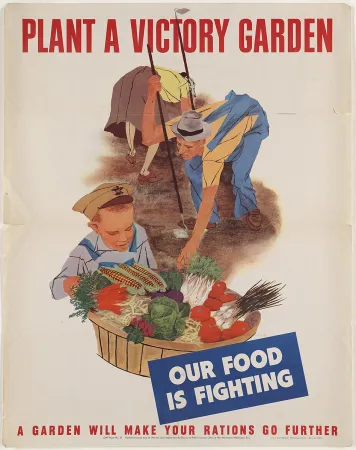
A downloadable version of this lesson is available here:
Community gardens are a form of green infrastructure often overlooked in urban climate change and development plans, despite many environmental benefits. For instance, they reduce urban heat islands, provide ecosystem services, and increase storm water retention. They also support sociological goals of trust-building, participation, and food security, which are especially critical for marginalized groups. These garden spaces sometimes spring up on contested, abandoned, or brownscape (old industrial site) properties with toxic residues, and historically have been challenged by other urban priorities like development and privatization. This lesson synthesizes the socio-environmental challenges and benefits of community gardens with the call for cities to designate more community garden space in planning for climate change, resilience, food security and sovereignty, and community integration. This lesson takes the form of a town hall meeting with city officials and residents weighing in on policy choices that will affect the gardens and the city’s climate resilience.
- Learn, articulate, and debate socio-environmental factors in community-garden planning.
- Consider the risks and rewards of community gardens in brownscapes (old industrial sites) and petroscapes (near roadways).
- Develop plans for grassroots governance that addresses vulnerable community needs.
- Synthesize community-garden ecosystem functions and services with longer-term municipal planning for green infrastructure and resilience amid climate change.
(5 min.) For 3 minutes, ask learners to share their knowledge of WWI- and WWII-era Victory Gardens—their purpose, location, and who worked in them—and ideas for what historical, political, and social needs they addressed at the time. Then, in a lightning session of 2 minutes, compare the utility of wartime gardens with the current need to build green infrastructure and provide nutritious food as climate change affects growing conditions. Ask learners what they can deduce from Victory Gardens that will help foster understanding and promote implementation of them to address the present time of rapid environmental change and inequality.
Community Gardens: Justice, Safety, and Climate Solutions (one, 75-minute class)
-
Preparatory homework: Prior to class, have learners read and take notes on the study by Clarke et al. (2019), linked below.
DocumentClarke et al. Urban Gardens.pdf (293.47 KB)Instruct learners to pay special attention to the highlighted portions, as well as the discussion and conclusion. Also, have learners view and take notes on the SESYNC webinar Urban Gardens and Environmental Injustices with Dr. Melanie Malone. Instruct them to pay special attention to the content within these timestamps:
3:20–4:40 — Gardens on Superfund sites
8:00–11:25 — Critical physical geography
17:50–20:55 — Common contaminants in garden soil
37:40–end — Conclusions and links to environmental justice (EJ)
-
(10 min.) To begin class, review the content of Clarke et al. and Malone’s work with the guidance of the lesson PPT slides below.
DocumentCommunity Gardens PPT.pptx (3.7 MB) -
(10 min.) Now, present the town hall scenario to the learners:
You live in a city with an industrial history that is in decline. As a result, there are hundreds of acres of open space, much of it brownscape with unknown levels of soil, water, and air contamination. Citizens and community organizers have created a network of community gardens on these properties. So far, city hall has tolerated the appropriation of these legacy sites because of the advantages to the community: social cohesion, exercise, food, and green space where there had been a growing proliferation of derelict spaces, crime, and indigence. In addition, the mayor is under pressure to outline resilience-building green infrastructure plans, as average temperatures and rainfall have increased during her tenure and the last hurricane season brought a close call with a storm that devastated a nearby town.
The main question at this town hall is: How should the city regulate these brownscape gardens? Should the city: 1) force their removal to make way for new development; 2) provide resources to make them safe and permanent; or 3) find a middle ground between these actions?
-
(10 min.) Next, establish roles for the town hall meeting. Ask the whole group for volunteers to: 1) play stakeholder roles—mayor, city planner, community organizer, soil toxicologist, nutritionist, and garden neighbor; and 2) be the official notetaker and post the meeting minutes to their class discussion board. (The notetaker and the rest of the learners will act as citizens at this town hall meeting.) Then, have participants get organized as follows:
Stakeholders: Have the six stakeholder role-players sit at a table facing the class with title cards identifying their roles. Ask them to to review facts and positions specific to their role based on their notes from the homework and supplemented, if needed, by a quick internet search.
Town citizens: Ask the other learners to submit questions that they think would be relevant to community members living in this area to the instructor via an online discussion board.
Facilitator: The instructor acts as the facilitator for the town hall. Select approximately seven questions, giving priority to those that best approach the themes of the lesson. For instance, those related to community-garden socio-environmental benefits; risks and unknowns of brownscape gardening; and building of proactive climate change resilience; among others.
-
(25 min.) Commence the town hall meeting. (If needed, remind participants to maintain constructive dialogue among people with differences of opinion and to keep an open mind.) Invite those learners whose questions have been selected to pose them to the stakeholders, one at a time. Though the stakeholders will role-play as “experts” in their field, they may need to be guided and informed by the instructor or peers during the Q&A. This time frame should allow five–seven questions to be asked, answered, and discussed (feel free to go on to others if time allows).
-
(5 min.) Conclude the town hall meeting. Ask the “mayor” to summarize their view of the situation and how their policies will address these complex issues with results expected by 2030. (They may be supported by the instructor in this summary of major points, conflicts, and concessions.)
-
(15 min) Ask the class to work collectively on the discussion forum to help the mayor develop a series of specific policy guidelines. These policies should balance the lesson themes while providing SMART (Specific, Measurable, Achievable, Realistic, and Timely) goals and objectives.
-
As homework, have learners review the draft policy document and provide at least two–three further edits, comments, and ideas for the synthesis of social, environmental, nutrition, and climate change needs. Instructors may finalize and post this document to the class discussion board, noting the community effort in working toward a cooperative and sustainable 2030.
-
Seeking justice, eating toxics: overlooked contaminants in urban community gardens
Urban community gardens can mitigate the effects of many environmental injustices, including the impact of food deserts, convenience store food, and pesticide-laden grocery items. Community gardens are also known to be located in contaminated locations in urban landscapes, including former brownfield sites, Superfund sites, and other abandoned spaces. Malone presents the challenges and barriers to gardening in contaminated spaces. She makes recommendations to address contamination and calls for better regulatory standards and other forms of support to mitigate risk to users.
Malone, M. (2022). Seeking justice, eating toxics: overlooked contaminants in urban community gardens. Agriculture and Human Values, 39, 165-184. https://doi.org/10.1007/s10460-021-10236-8
-
Sustainable Food Systems for Future Cities: The Potential of Urban Agriculture
Urban agriculture is beneficial in both post-industrial and developing cities because it touches on the three pillars of sustainability: economics, society, and the environment. Urban agriculture not only provides a source of healthful sustenance that might otherwise be lacking, it can also contribute to a household’s income, offset food expenditures, and create jobs. As a form of green infrastructure, urban farms and community food gardens help reduce urban heat island effects, mitigate urban stormwater impacts, and lower the energy embodied in food transportation. This paper describes a multi-year study undertaken by the Urban Design Laboratory at the Earth Institute to assess the opportunities and challenges associated with the development of urban agriculture in New York City.
Ackerman, K., Conard, M., Culligan, P. et al. (2014). Sustainable Food Systems for Future Cities: The Potential of Urban Agriculture. The Economic and Social Review, 45(2). https://www.esr.ie/article/view/136
-
How community gardens may contribute to community resilience following an earthquake
Following extreme storm events, community gardens can supply food, enhance social empowerment, provide safe gathering spots, and promote restorative practices to remind people of normality. This garden study based in post-earthquake New Zealand shows how the space served as an important place to de-stress, share experiences, and gain community support. Garden features that reportedly supported disaster recovery include facilities that encourage social interaction and bonding such as central meeting and lunch places and communal working areas.
Shimpo, N., Wesener, A., & McWilliam, W. (2019). How community gardens may contribute to community resilience following an earthquake, Urban Forestry & Urban Greening, 38, 124-132. https://doi.org/10.1016/j.ufug.2018.12.002
